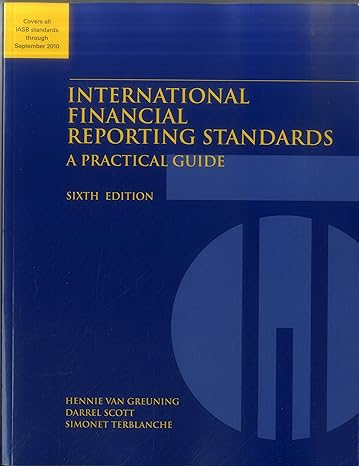Question
Can someone help me do these? I'd like to see how they were done as well so I know how to do them in the
Can someone help me do these? I'd like to see how they were done as well so I know how to do them in the future please.
1. You calculated that the average return of your portfolio is 5% and the standard deviation is 21%, what is the value at risk (VaR) at 5% for your portfolio?
2. A portfolio with a 15% standard deviation generated a return of 5% last year when risk free T-bills were paying 1%. You are considering adding one more stock to your portfolio, the stock will boost the portfolios expected return to 15% while also increases the standard deviation to 30%. If you are interested in the best risk versus return trade-off, should you add the stock?
| A. | Yes because it increases the portfolio's Sharpe ratio to 0.50 | |
| B. | Yes because it increases portfolio's return to 15%. | |
| C. | No because it decreases the portfolio's sharpe ratio to 0.267 | |
| D. | Yes because it increases portfolio's Sharpe ratio to 0.467 | |
| E. | No because it increases the risk of the portfolio |
3. You have been following a stock for 4 months and the following is its past return
Year 1: 2%
Year 2: 19%
Year 3: 3%
Year 4: -5%
What is the expected return based on historical data? (Put answer in decimal points instead of percentage)
4. Your investment has a 30% chance of earning a 11% rate of return, a 40% chance of earning a 16% rate of return and a 30% chance of earning -4%. What is the standard deviation on this investment? (Put your answers in decimal points instead of percentage)
5. The returns of a mutual fund manager for the past 3 years are the following:
Year 1: 7%
Year 2: 14%
Year 3: -3%
What is the geometric average return of the fund for the past three years? Put return in decimal points instead of percentage.
6. You have been following a stock for 3 months and the following is its past return
Year 1: 13%
Year 2: 13%
Year 3: -8%
What is the standard deviation of the stock based on the historical data? (Put the answer in decimal points instead of percentage)
Step by Step Solution
There are 3 Steps involved in it
Step: 1

Get Instant Access to Expert-Tailored Solutions
See step-by-step solutions with expert insights and AI powered tools for academic success
Step: 2

Step: 3

Ace Your Homework with AI
Get the answers you need in no time with our AI-driven, step-by-step assistance
Get Started


